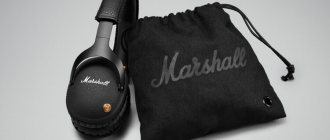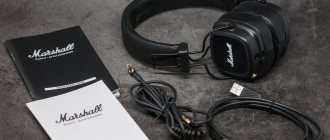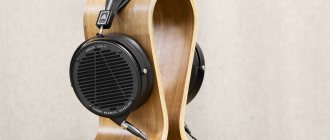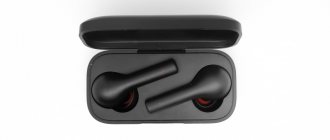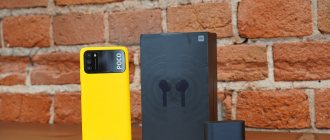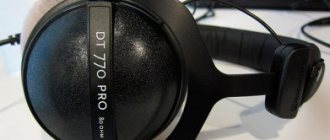How LCD-2C and LCD-1 work
Both headphone models are of the planar or isodynamic/orthodynamic type.
They work on the basis of emitters of the same name. Planar headphones work like this: we have a flat diffuser in the form of an ultra-thin polymer membrane with conductive tracks. The membrane, in turn, is located between two magnetic grids. Due to this design, smoother and faster oscillations are ensured, hence a much smoother frequency response and a minimum of nonlinear distortions.
As a result, we get detailed and natural sound, much lower impedance and very high sensitivity. Sensitivity further results in the fact that the headphones make obvious the shortcomings of the signal from a low-quality source. And due to the small stroke of the membrane, the headphones have to be made larger so that the lower register does not suffer.
The company and its products
The American company Audeze is just over ten years old.
This is a high-tech enterprise that develops high-quality headphones based on magnetoplanar technology. Most of their devices have an open acoustic design. This is due to the fact that in closed versions a closed volume is created between the membrane and the outer wall of the cup, which acts as a shock absorber. This contributes to a decrease in sound quality, as the details of the phonogram are extinguished.
Open models will suit any music lover. Only those around you may not like the volume of their sound, which extends several meters from the source.
What they look like
The LCD-1 comes in a proprietary case with a cable and an adapter for a 6.3 mm jack. The body is completely plastic, the design is foldable. The headphones weigh 250 grams, so they are convenient to take with you on trips or to someone else’s studio, and your head will not get tired from long sessions. The ear pads are large, covering, trimmed with leather, and the internal material “remembers” the shape of the owner’s ears. The fabric-braided cable does not tangle and connects to each driver separately using 3.5 mm jacks.
The LCD-2C is very similar in appearance and layout to the original LCD-2, but plastic is now used instead of wood. It doesn't look as elegant and noble, but it doesn't require the same careful handling. Unlike LCD-1, here the connection to the drivers occurs using mini-XLR cables. The ear pads are large and cover the ears quite tightly, although, of course, we are not talking about the isolation level of closed headphones. LCD-2C is supplied without a case.
Miscellaneous clothes
In order to diversify the acquaintance with the LCD-2 models, the new modification was chosen in a special Leather Free version, where all leather elements were replaced with velor. A direct comparison of the LCD-2 Leather Free and LCD2 Classic, in principle, leaves no chance to doubt that these are the same headphones, differing from each other mainly in decorative elements. But it is precisely because of the finishing that they look and are perceived completely differently.
The choice of finish fundamentally changes the very perception of the model
LCD2 Classic look extremely stern and brutal. They're dressed all in black: black metal earcup body, bare metal headband with perforated leather cushion, black leather ear pads. Either studio monitors, or a BDSM accessory... But the LCD-2 Leather Free produces exactly the opposite impression and looks much more homey. The cups are made of bamboo, the metal headband and ear pads are covered with soft, warm and pleasant to the touch velor. The stereotypical fireplace, blanket and amplifier lamps glowing in the semi-darkness appear in the head by themselves.
The same headband design can have different implementations
And although the models have almost parity in terms of comfort of fit - both of them, with a weight of a good half a kilo, do not put pressure on the head and do not feel particularly heavy - the LCD-2 Leather Free still seems more comfortable. These are the headphones you want to hold in your hands or wear on your head. By the way, velor is an artificial material that has nothing to do with natural leather, so the LCD-2 Leather Free model was born without sacrifices in the form of slaughtering young lambs in order to cover the ear pads and headband pillows with soft leather. Except that one middle-aged bamboo was cut down to create a pair of chic lacquered cups.
Standard mini XLR connectors allow you to choose from a wide variety of cables
But the most curious thing is that the LCD2 Classic model, which looks very leather, in fact also does not use materials of animal origin. The delicate material that covers the lush ear pads and the thick, rough headband cushion are excellent examples of the highest quality eco-leather. And this was done not because the manufacturer felt sorry for the natural leather for its customers, but because the customers felt sorry for the animals. Refusal to use genuine leather is a new fashion trend in the USA (the homeland of Audeze headphones).
What do they sound like?
- Subjectively
LCD-1s are distinguished by detail, transparency, picture clarity and balance. They are suitable for professionals and those amateurs who like to listen to music analytically and go into detail. A very precisely maintained balance, on the one hand, allows you to hear very subtle nuances, but on the other hand, it will not color the sound.
Therefore, for those who listen to music solely for pleasure and do not like to dig into details, it is better to pay attention to devices with a more pronounced character (and accompanying changes in the frequency response). The signature tonal balance is also good because the listener gets tired of the audio much more quickly.
But it should be noted that the LCD-1 is much more tolerant of equipment than other planar headphones, and purchasing a separate preamp is still not necessary.
In the LCD-2 Classic, the spatial distribution of the signal immediately catches your eye. The listener receives a single scene, a space from which not a single event falls out, regardless of register.
The model has expressive bass, and its proprietary readability even better helps to find details and nuances in tracks.
The upper register is quite bright, but in the overall picture it does not dominate and does not interfere with the perception of the track as a whole. Therefore, modern compositions, highly compressed and with very pronounced highs, will sound convincing. And even at high volumes, the LCD-2Cs do not distort the signal - thanks to the design.
- Objectively
Main technical characteristics:
LCD-1
- Type: open, full-size;
- Emitter type: planar;
- Magnet placement: one-sided;
- Emitter diameter: 90 mm;
- Magnet material: Neodymium N50;
- Maximum input power: 5 W RMS;
- Sound pressure level: >120 dB;
- Frequency range: 10 Hz – 50 kHz;
- Total Harmonic Distortion: <0.1% @ 100dB;
- Impedance: 16 Ohm;
- Sensitivity: 99 dB/1 mW;
- Weight: 250 g.
LCD-2C
- Type: full-size, open;
- Emitter type: planar;
- Magnet arrangement: double;
- Magnet material: Neodymium N50;
- Emitter diameter 106 mm;
- Maximum power input: 5 W RMS / 15 W (peak);
- Maximum sound pressure: >130 dB;
- Frequency range: 10 Hz – 50 kHz;
- Total Harmonic Distortion: <0.1% at 100 dB;
- Impedance: 70 Ohm;
- Sensitivity: 101 dB/1 mW (when taken at DRP);
- Recommended amplifier power: >100 mW;
- Weight: 550 g.
Measurements
Comparative listening of the two models gave completely different sensations, and I was absolutely sure that the difference in the bass region would be much more significant. However, here we have a completely different situation. Both models have an almost linear frequency response graph at up to 400 Hz, and then the frequency response begins to change smoothly.
The frequency response of the new version of LCD-2 is generally more linear. The drop in bass response from 30 Hz and below is not very pleasing, but at mid frequencies a straight line is maintained up to 1 kHz.
The sound character of the LCD2 Classic is determined by a seemingly insignificant increase in the frequency response. The degree of its influence on perception is determined by the frequency range: our hearing is most sensitive to the midrange, and the slopes of the frequency response in this area largely determine how we perceive the sound picture as a whole. In this case, we have an emphasis on the upper part of the vocal range, highlighting and “drying” the sound.
When directly comparing the average frequency response graphs of two models, it is easy to see how small the difference is overall, and how exactly they differ from each other. It is noteworthy that the region above 2.2 kHz is very similar for both headphones, not to mention the almost complete identity of the 30-400 Hz region.
Both the LCD-2 Leather Free and LCD2 Classic demonstrated exceptionally low distortion. In the main part, the graph runs along the -0.2% mark, and it does not rise above -0.5%, with the exception of the lower bass area. Local spikes noticeable when smoothing 1/12 octave indicate that even the powerful Schiit Ragnarok is not so easy to work with headphones.
Who needs
Both models clearly illustrate the advantages of isodynamic headphones: low distortion even at high volumes, smooth frequency response, excellent detailed sound and a balanced picture as a whole. But such impartiality of the resulting picture will not appeal to those who need a specific sound color from their headphones.
As for the LCD-1, here we see a rare case of affordable planar headphones. LCD-1 are not so demanding on the audio signal source and can be used not only by professionals. Although for them these headphones will be a good choice. According to their parameters, they are suitable as a working tool, especially if you need to work outside of your studio. Moreover, their form factor is just right for taking with you, since they fold and weigh only 250 grams.
LCD-2 Classic is the choice of professionals and the most demanding audiophiles who love to analyze music. The sound is very precise and full of detail, and any genre is revealed here reliably and without distortion. The only thing is that with these headphones you may have to reconsider the device as a whole - the LCD-2 Classic are quite demanding in terms of amplification and will not be fully developed on budget equipment.
- Buy Audeze LCD-1
- Buy Audeze LCD-2C
What is inside
The radiating surface area of each Audeze LCD-2 Closed Back earphone is 88 cm2. The diaphragms are made of thin polymer. The flat conductive layer here is applied by vacuum deposition. The magnetic field is made uniform by several pieces of N50 neodymium.
There are no proprietary Fazor acoustic elements, as in the manufacturer’s flagship devices. The quality does not suffer much from this, but the price turned out to be humane.
Both cups are equipped with mini-XLR connectors that securely secure the plugs of a wired device. It comes with a 190 cm long braided cable.
The rigidity of the design of the headphones is given by cups made of “Liquid wood” polymer. It is enhanced with crystalline additives. An even harder material was used on the sides, which will not allow scratches to appear on the product in the event of an unsuccessful touch.
Excellent sound
The manufacturer recommends loading the LCD-2 Closed Back with a power of at least 250 mW. Most good players can do this, but not all smartphones, even middle-class ones, will be able to produce such a signal.
These headphones sound amazing. The highs here, by definition, should be dull, but they are light and light. This became possible thanks to the presence of almost weightless membranes, which prevent the sound from becoming harsh and harsh.
At the same time, there are not very many low frequencies here, but enough. Despite the closed design of the device, they are moderately mobile and prominent. In order to fully get an idea of the sound quality, you do not need to turn the volume up to maximum values.
If you don’t delve into the detailed characteristics of the vocals, they can be described in one word – restrained. The sound is bright, detailed, but not loud. Any music lover will feel the seismic power of Jose Carreras and the insinuating half-whisper of Melody Gardot.
It is not difficult to conclude that the LCD-2 Closed Back is free both from genre restrictions and from the bright manifestations of the specifics of a closed acoustic circuit. They show rigor only in relation to the class of amplifiers. If you use a system with low power supply or various shortcomings when supplying frequencies (especially high ones), then there will not be good sound.
Results
The Audeze LCD-2 Closed Back combines a cool planar magneto design with a closed acoustic design.
These are large, well-built headphones. They produce a light and prominent sound. Moreover, its quality does not depend on the environment.
Interestingly, the manufacturer’s engineers have developed an accessory whose design allows for upgrades. Those who wish can install a carbon fiber headband and use a balanced cable instead of the standard one.
It is also possible to order the accessory trimmed with genuine leather. However, all this is designed for a very picky buyer; the standard materials used are quite good. Most consumers will be satisfied with them.
Heavy artillery
Despite being closely related to the LCD-X model, the LCD-XC headphones have a completely different sound character. Closing the cabinets not only changed the sound stage, but also affected the frequency response. The stage of both models turned out to be more intimate, crowded, it does not extend widely even when using a balanced connection. However, for closed-back headphones, it's wide enough to not feel cramped.
Metal headband with perforated leather pad fits perfectly into the LCD2 Closed-Back design
As for the frequency response, the sound of the LCD-XC, despite having a studio pedigree, is rather commercial. The character is dark, somewhat ponderous. The main accents fall on the edges of the range, emphasizing the lower bass and high frequencies, while moving the mid frequencies away from the listener. We are, of course, not talking about a frankly V-shaped frequency response with a difference of one and a half dozen decibels. However, after the absolutely linear open models of Audeze, these seem bright in the treble and bassy.
If we consider the LCD-XC as monitors intended for listening to the final version of the mix, then this approach seems absolutely justified to me. After all, it is precisely this character that manufacturers working for the mass market strive to give to their headphones. At the same time, in comparison with most “store” headphones, the LCD-XC has one important difference - they have a significantly higher resolution.
Mini-XLR connectors are reliable, and most importantly, they are quite common, which allows you to “play” with replacing cables for as long as you like.
LCD2 Closed-Back surprises primarily with the quantity and quality of high frequencies. Only in-channel LCD-i4 provided such top-of-the-line LCDs. As a result, the sound is rather bright, and the tonal balance from edge to edge feels smoother than that of the LCD-XC. But against the backdrop of open models, it’s still not ideal, and a dip in the frequency response in the midrange can be noticed.
Due to the specific acoustic design, both closed models cope with the bass range not as confidently as open LCD headphones. There is more bass in quantity, it is not as elastic and clear as open ones. For example, the bass drum beats in the metal and the fast passages of Marcus Miller are no longer played as collected and focused as on similar open models. At the same time, the sound of the double bass does not cause any particular complaints - all notes are quite legible. Not too experimental and aggressive jazz is quite harmonious, and there are no complaints at all with blues.
The LCD series headphones themselves are quite large, and also have a solid range of headband adjustment
LCD2's Closed-Back - Mighty Sam McClain's "Give It Up To Love" sounds open, with a bright, prominent mids and a wide stage. In the foreground are vocals, cymbals and guitar. There is more bass on the LCD-XC, it fills a significant space, and the vocals along with the cymbals are moved further from the listener, deeper into the stage, which is why the composition becomes imposing and relaxed.
“Crazy Train” by Ozzy Osbourne on the LCD-XC sounds muffled, as if a little far away. For some reason, I immediately imagined that vinyl was playing on a vintage system with large bookshelves like JBL L100. It's a completely different story with LCD2 Closed-Back - they play more aggressively and tend to put music on shelves, so they are more likely associated with modern speakers or even studio monitors. In their performance, the guitars sound much brighter; there is no talk of softening the vocals or “rounding” sharp corners. And if I choose between these two interpretations, the LCD-XC version seemed more authentic to me.
But everything changed radically when I came to Stevie Ray Vaughan's "Crossfire". It would seem that “vintage” mastering, similar in nature, should have given the same result. But the LCD-XC made the sound of this recording too dark, and the LCD2 Closed-Back, on the contrary, brought the guitar and vocals into the light. The composition turned out to be more interesting and brighter.
The standard cable has a lot of alternatives, the main one of which I would call the balanced version of the cable
I have seen such metamorphoses more than once. Both classical music and examples of modern EDM culture contained compositions that were best listened to on one model. However, there were also those who played well in both variations. At the same time, I could not predict which headphones would “shoot” in this or that case. For example, I expected that the Zaz would play only on the LCD-XC, and the LCD2 Closed-Back would make the sound too bright, but both models worked with a bang, although their emphasis was different. What’s remarkable is that both pairs of headphones gave a completely comparable feeling of dynamics and rhythm.
Having the same acoustic design, the headphones still differ in quality class. This is naturally reflected in the degree of detail and the nature of the presentation. LCD2 Closed-Back slightly simplify the nuances and sound strictly, like open LCD2 Classic. And the LCD-XC model gives a thick sound, rich in timbres, and in this it is more reminiscent of the LCD-3.
